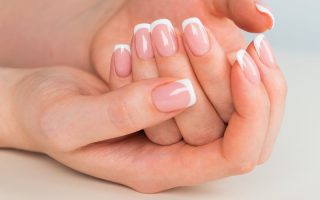Nail discoloration can be a concerning issue, affecting both the appearance and health of your nails. Various factors can cause discoloration, including infections, trauma, and exposure to harsh chemicals. Understanding the causes and treatments for nail discoloration can help you maintain healthy and attractive nails. This article will guide you through the steps to deal with nail discoloration effectively.
Understanding Nail Discoloration
Nail discoloration refers to any change in the natural color of your nails. Healthy nails are generally pink with a white lunula (the half-moon shape at the base). Discoloration can appear in various shades, such as yellow, brown, green, or black, depending on the underlying cause.
Common Causes of Nail Discoloration
- Fungal Infections: Often cause yellow or greenish discoloration. Fungal infections can make nails thick, brittle, and crumbly.
- Trauma: Injury to the nail can lead to bruising, which appears as black or purple discoloration.
- Chemical Exposure: Harsh chemicals, like those found in cleaning products or nail polish removers, can cause yellowing of the nails.
- Health Conditions: Diseases such as diabetes, psoriasis, or thyroid disorders can lead to changes in nail color.
- Medications: Certain medications, like chemotherapy drugs, can cause nail discoloration as a side effect.
Prevention Tips
Prevention is key. Using gloves when cleaning, gardening, or using harsh chemicals can protect your nails from discoloration, as noted by Dr. Adam Friedman, a dermatologist at George Washington University Hospital. Keeping your nails clean and dry is also crucial to preventing infections.
Protective Measures
- Wear Gloves: Always wear gloves when handling chemicals or doing tasks that might injure your nails.
- Moisturize: Regularly apply hand cream or cuticle oil to keep your nails and surrounding skin hydrated.
- Avoid Harsh Products: Use gentle, non-toxic nail polishes and removers.
Treatment Options
Home Remedies
While home remedies can be effective for mild discoloration, they should be used with caution. Dr. Joshua Zeichner from Mount Sinai Hospital suggests that home remedies like lemon juice or baking soda may offer mild bleaching effects but can be harsh on the skin.
Lemon Juice
Lemon juice has natural bleaching properties. Soak your nails in a mixture of lemon juice and water for a few minutes, then rinse thoroughly. Repeat this process a few times a week.
Baking Soda
Baking soda can help remove surface stains. Make a paste with baking soda and water, apply it to your nails, and gently scrub with a soft toothbrush. Rinse well and moisturize afterward.
Over-the-Counter Treatments
Topical treatments, such as nail polish removers containing acetone, can help remove surface stains but may also damage the nails, according to Dr. Jennifer Lin from Lenox Hill Hospital. Use these products sparingly and always follow up with a moisturizer.
Prescription Treatments
For more persistent discoloration, prescription treatments may be necessary. Antifungal medications, both topical and oral, are effective against fungal infections. Your healthcare provider can recommend the best treatment based on the severity of the infection.
Professional Treatments
Laser therapy can effectively target and remove stubborn nail discoloration caused by fungal infections or trauma, as explained by Dr. Sheel Desai Solomon from Yale New Haven Hospital. This treatment uses focused light to penetrate the nail and eliminate the infection without damaging surrounding tissues.
When to See a Doctor
It’s essential to consult a healthcare professional if you notice significant changes in your nail color, thickness, or texture. Nail discoloration can sometimes indicate underlying health issues that require medical attention. Conditions like diabetes or thyroid disorders can manifest through changes in your nails.
Statistics on Nail Discoloration
A study published in the Journal of the American Academy of Dermatology titled “Impact of Nail Discoloration on Quality of Life: A Cross-Sectional Survey Study” (2021) found that nail discoloration significantly affects individuals’ quality of life, causing distress and reducing self-esteem. Another study, “Treatment of Nail Discoloration: A Comprehensive Review of Available Therapies” (2020), published in the Journal of Cosmetic Dermatology, reviewed various treatments and emphasized the importance of early intervention to prevent complications.
Personal Insights
From my own experience, dealing with nail discoloration required a combination of prevention and treatment. Wearing gloves while cleaning and gardening significantly reduced my exposure to harsh chemicals. I also found that soaking my nails in lemon juice helped lighten mild discoloration, though I had to be careful not to overdo it to avoid skin irritation.
A friend of mine dealt with persistent fungal infections. She tried various over-the-counter treatments with little success. Finally, she consulted a dermatologist who prescribed an oral antifungal medication. This, combined with regular professional nail care, cleared up the infection and restored her nails’ natural color.
Maintaining Healthy Nails
To keep your nails healthy and prevent discoloration, follow these tips:
Regular Nail Care
- Trim and File: Keep your nails trimmed and filed to prevent them from becoming damaged or infected.
- Clean and Dry: Always keep your nails clean and dry to prevent infections.
- Moisturize: Regularly apply hand cream and cuticle oil to keep your nails hydrated.
Healthy Lifestyle
- Balanced Diet: Eating a diet rich in vitamins and minerals supports nail health. Include foods high in biotin, iron, and zinc.
- Hydration: Drink plenty of water to keep your nails and skin hydrated.
- Avoid Smoking: Smoking can affect blood flow to the nails and contribute to discoloration.
Regular Check-Ups
Regular visits to a healthcare provider can help identify and address any underlying health issues that may be affecting your nails. Early intervention is crucial to prevent complications and maintain healthy nails.
Conclusion
Dealing with nail discoloration involves a combination of prevention, home remedies, and professional treatments. By protecting your nails from harsh chemicals, maintaining a regular nail care routine, and seeking medical advice when necessary, you can keep your nails healthy and attractive. Remember, your nails can provide valuable insights into your overall health, so pay attention to any changes and take action promptly. With the right care and attention, you can enjoy beautiful, healthy nails.



